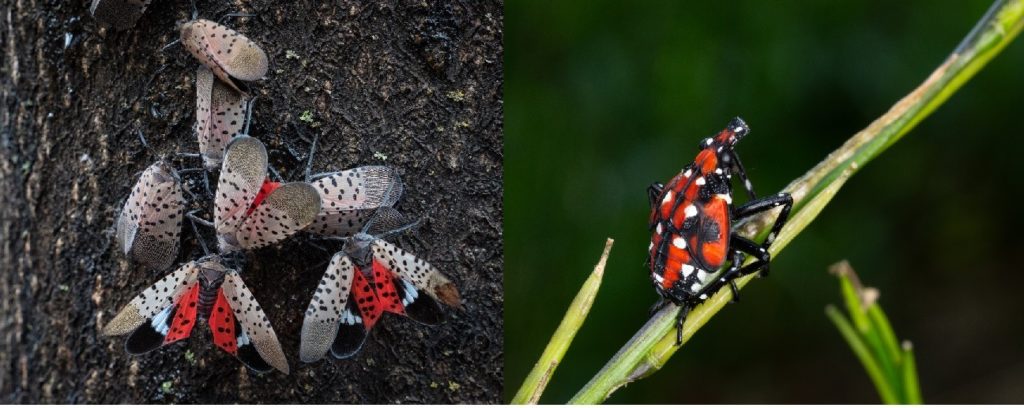The State We're In
Lanternflies spreading, but not on Christmas trees
Spotted lanternflies are invading from Pennsylvania into eight New Jersey counties! Fortunately for New Jersey Christmas tree farmers – and Christmas tree lovers – these alien pests don’t like the taste of evergreens.
“They’re absolutely not a problem for us,” said Donna Allison Cole, executive secretary of the New Jersey Christmas Tree Growers Association. “Christmas trees aren’t hosts for spotted lanternflies. They prefer fruit orchards and grape vineyards.”
Spotted lanternflies caused a stir two winters ago, when their egg masses were found on a Christmas tree from Pennsylvania that was brought into a New Jersey home. The ensuing publicity launched a scare that has yet to fully die down.
“It was just one Christmas tree, but newspapers from Virginia to Boston picked up the story,” lamented Tim Dunne, vice president of the Christmas Tree Growers Association.
Since then, tens of thousands of Christmas trees have been grown and sold in New Jersey, with no evidence of spotted lanternflies. But stories still pop up about lanternfly eggs hatching on Christmas trees.
“As far as I’m concerned, it’s the Grinch that stole Christmas. We’re all tired of hearing about it,” said Dunne, who is certified to inspect for spotted lanternflies. “We look at all our trees, and I’ve yet to see a lanternfly here or on any Christmas tree.”
Native to Asia, spotted lanternflies were accidentally introduced into Pennsylvania in 2014. In 2018, they crossed the Delaware River into three New Jersey counties – Mercer, Hunterdon and Warren. This past summer, they spread to Burlington, Camden, Gloucester, Salem and Somerset counties.
Spotted lanternflies are in the “plant hopper” group of insects. Their mouth parts act like long straws, able to pierce plant tissues and suck out the sap.
Lanternflies are a threat to New Jersey’s farms and vineyards because they feed on apple, peach and cherry trees, grape vines, basil plants, vegetables and hops. They could also potentially harm New Jersey’s forests, as they’re known to feed on willow, black walnut, maple and oak trees. The loss of sap can weaken infested trees and plants.
Emile DeVito, New Jersey Conservation Foundation’s staff biologist, says the key to controlling spotted lanternflies may lie with their favorite food source, the invasive Tree of Heaven, Ailanthus altissima. Research indicates that spotted lanternflies may need the sap of the Tree of Heaven – also a native of Asia – to reproduce.
Trees of Heaven are common throughout New Jersey, especially in areas with human disturbance. They look very similar to native sumac trees.
One strategy being considered by the New Jersey Department of Agriculture, said Emile, is cutting down smaller Trees of Heaven and leaving larger ones to lure spotted lanternflies. These large Trees of Heaven could then be injected with insecticides to poison the lanternflies.
“By using large Tree of Heaven specimens as ‘insecticidal traps’ to kill adult lantern flies before they reproduce, the Department of Agriculture might be able to limit their population explosion,” said Emile. “Spotted lanternflies are spreading so fast that soon they’ll be everywhere. Tree of Heaven is abundant in cities, along roadways, and in edges of farmland, so lanternflies will find their way into every nook and cranny of the state.
“The general public can get involved by alerting the Department of Agriculture to establish these Tree of Heaven ‘trap trees.’ Maybe we can limit damage to crops and native trees until an effective biological control organism is found in the future,” Emile added. “People should contact Department of Agriculture specialists and welcome them onto their properties to deal with the Tree of Heaven. Insecticides aren’t injected until well after the spring bird migration, and Tree of Heaven is seldom visited by native birds, so impacts to sensitive insect-eating birds would be negligible.”
This time of year New Jerseyans won’t see spotted lanternflies, which are distinctive for their grayish-brown forewings with black spots, and bright red hind wings with black spots. Cold weather has killed the adults.
But lanternfly eggs can survive winter’s freezing temperatures and hatch in the spring. Spotted lanternflies lay their eggs on almost any smooth surface, including cars, outdoor furniture, barbecue grills, trash cans, firewood and cinder blocks. Egg masses resemble grayish-brown splotches of mud.
If you find spotted lanternfly egg masses, you can scrape them off, double bag them and toss them in the trash. Eggs can also be killed by bleach, alcohol or hand sanitizer. Please report egg masses to the state Department of Agriculture by calling their hotline number — 833-BADBUG-0 (833-223-2840) — or sending an email to slf-plantindustry@ag.nj.gov.
To learn more about spotted lanternflies, go to https://www.nj.gov/agriculture/divisions/pi/prog/spottedlanternfly.html and https://www.aphis.usda.gov/aphis/resources/pests-diseases/hungry-pests/slf/spotted-lanternfly.
And for information about preserving New Jersey’s land and natural resources, visit the New Jersey Conservation Foundation website at www.njconservation.org or contact me at info@njconservation.org.
About the Authors
Alison Mitchell
Co-Executive Director
John S. Watson, Jr.
Co-Executive Director
Tom Gilbert
Co-Executive Director, 2022-2023
Michele S. Byers
Executive Director, 1999-2021
View their full bios here.
Filter
Get The Latest News
From The Garden State
In the
News

